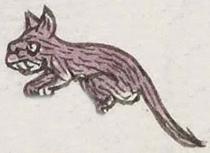quimichin (Mdz16r)
This element for mouse (quimichin) has been carved from the compound sign for the place name, Quimichtepec (shown below, right). In this profile view, the mouse is facing to our left. Its coat is painted purple. Its belly is white, as are its eye, fangs, and claws.
Stephanie Wood
This rat could symbolize something about the local animal population, but it could also be a reference to merchants (who travel a lot and have opportunities to gather information to bring back to the emperor), eavesdroppers, and/or outright spies, given the associations rats have with such people, as explained for school children by Ian Mursell in Mexicolore.
Stephanie Wood
c. 1541, but by 1553 at the latest
Stephanie Wood
mouse, mice, ratones, colmillos

quimich(in), mouse, a rodent, https://nahuatl.wired-humanities.org/content/quimichin
mouse
el ratón
Stephanie Wood
Codex Mendoza, folio 16 recto, https://digital.bodleian.ox.ac.uk/objects/2fea788e-2aa2-4f08-b6d9-648c00..., image 42 of 188.
The Bodleian Libraries, University of Oxford, hold the original manuscript, the MS. Arch. Selden. A. 1. This image is published here under the UK Creative Commons, “Attribution-NonCommercial-ShareAlike 3.0 License” (CC-BY-NC-SA 3.0).

